Accounting Theory & Contemporary Issues: The Impact of AI - ACCM 4600
VerifiedAdded on 2023/06/15
|20
|4888
|371
Report
AI Summary
This report examines the impact of artificial intelligence (AI) on accounting theory and contemporary issues. It begins by providing a background on AI, its purpose, and scope within the accounting profession. The report discusses the theoretical underpinnings of AI, tracing its development from the mid-20th century to the present day. It explores the opportunities presented by AI, such as improved data analysis, fraud detection, and portfolio management, as well as the threats, including potential job displacement and ethical concerns. The analysis covers how AI is changing accountants' work, streamlining tasks, and providing better access to data. The report concludes with recommendations for businesses to leverage AI effectively while mitigating its risks. Desklib offers this assignment solution and many other resources like past papers for students.
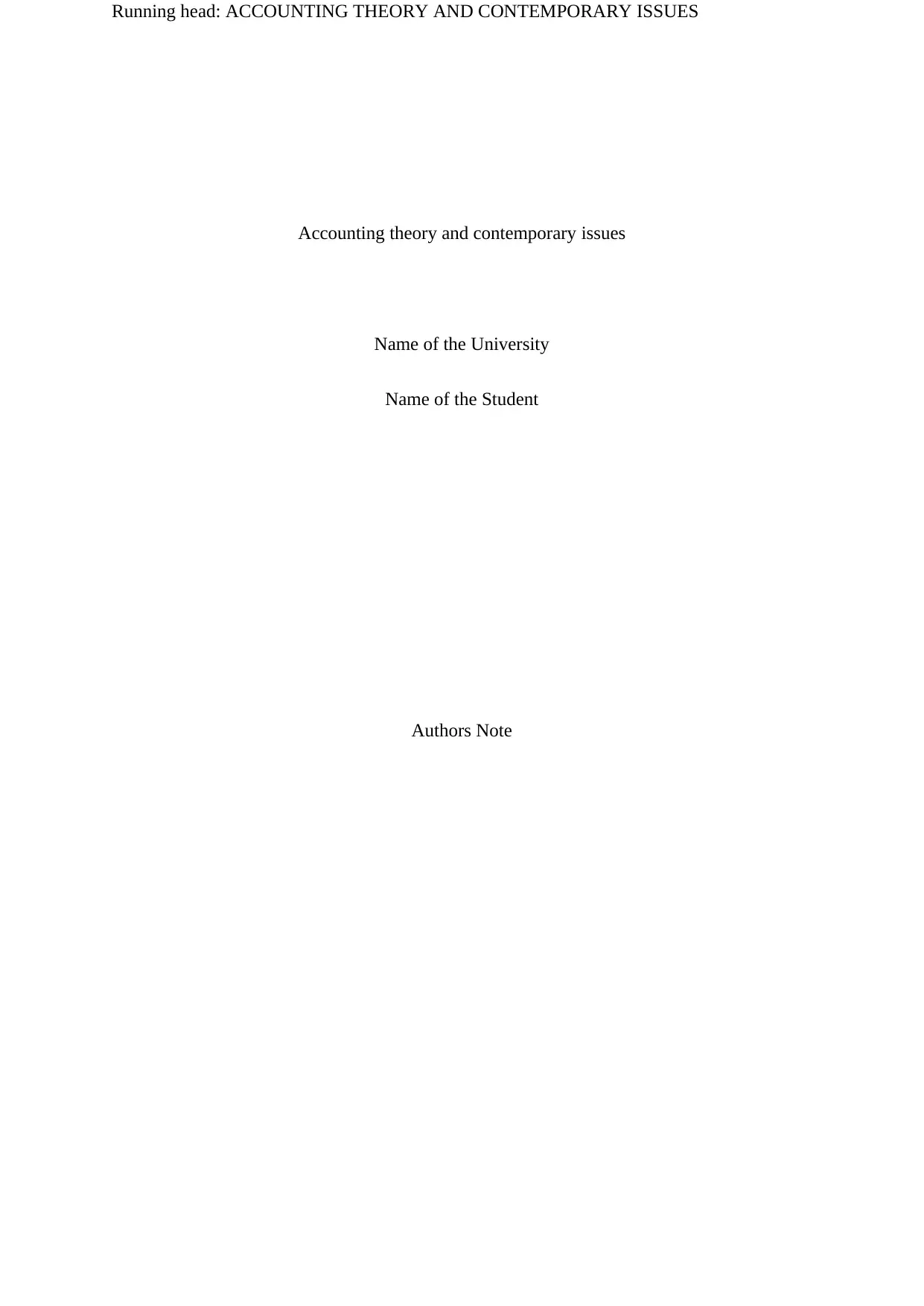
Running head: ACCOUNTING THEORY AND CONTEMPORARY ISSUES
Accounting theory and contemporary issues
Name of the University
Name of the Student
Authors Note
Accounting theory and contemporary issues
Name of the University
Name of the Student
Authors Note
Paraphrase This Document
Need a fresh take? Get an instant paraphrase of this document with our AI Paraphraser
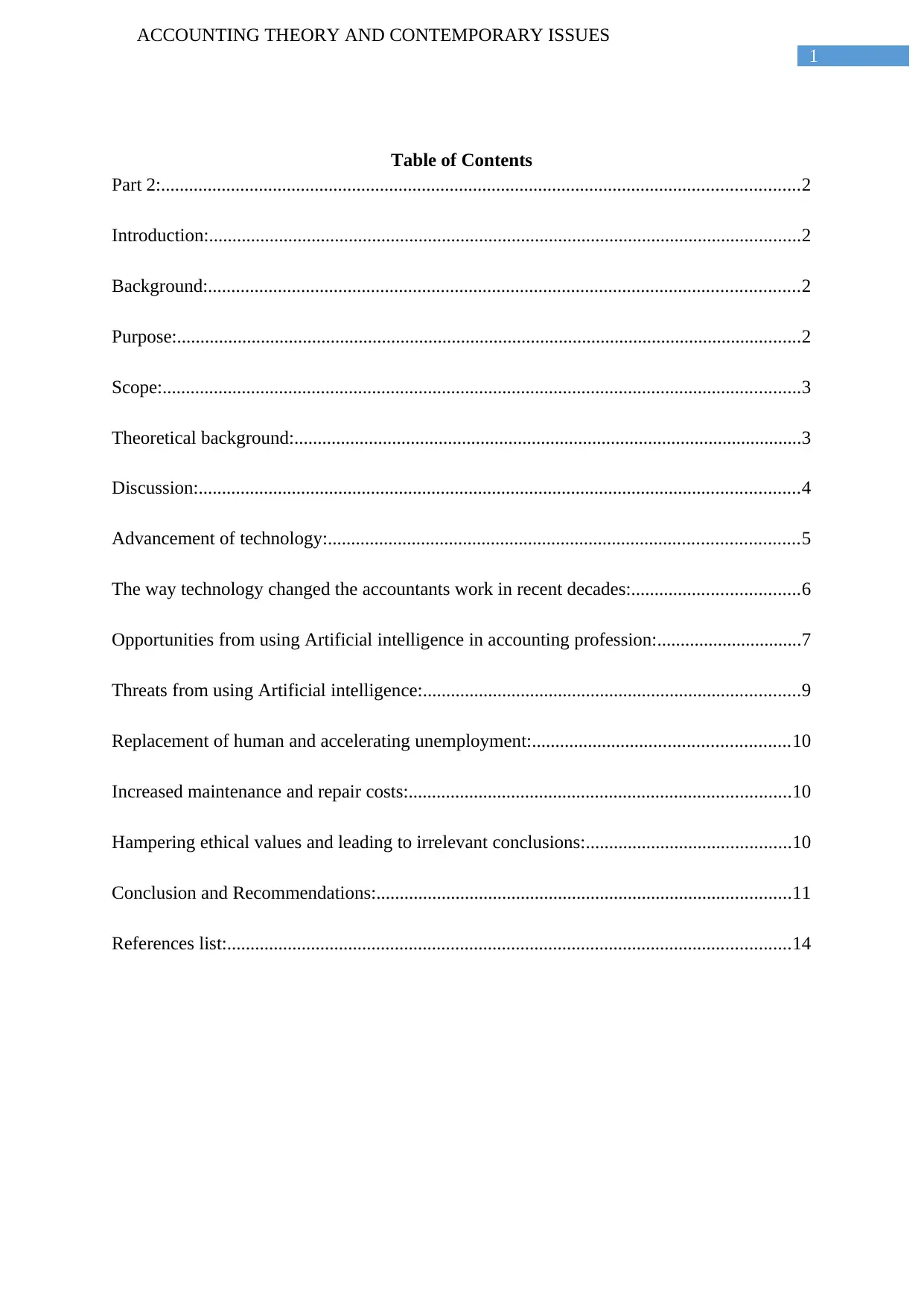
1
ACCOUNTING THEORY AND CONTEMPORARY ISSUES
Table of Contents
Part 2:.........................................................................................................................................2
Introduction:...............................................................................................................................2
Background:...............................................................................................................................2
Purpose:......................................................................................................................................2
Scope:.........................................................................................................................................3
Theoretical background:.............................................................................................................3
Discussion:.................................................................................................................................4
Advancement of technology:.....................................................................................................5
The way technology changed the accountants work in recent decades:....................................6
Opportunities from using Artificial intelligence in accounting profession:...............................7
Threats from using Artificial intelligence:.................................................................................9
Replacement of human and accelerating unemployment:.......................................................10
Increased maintenance and repair costs:..................................................................................10
Hampering ethical values and leading to irrelevant conclusions:............................................10
Conclusion and Recommendations:.........................................................................................11
References list:.........................................................................................................................14
ACCOUNTING THEORY AND CONTEMPORARY ISSUES
Table of Contents
Part 2:.........................................................................................................................................2
Introduction:...............................................................................................................................2
Background:...............................................................................................................................2
Purpose:......................................................................................................................................2
Scope:.........................................................................................................................................3
Theoretical background:.............................................................................................................3
Discussion:.................................................................................................................................4
Advancement of technology:.....................................................................................................5
The way technology changed the accountants work in recent decades:....................................6
Opportunities from using Artificial intelligence in accounting profession:...............................7
Threats from using Artificial intelligence:.................................................................................9
Replacement of human and accelerating unemployment:.......................................................10
Increased maintenance and repair costs:..................................................................................10
Hampering ethical values and leading to irrelevant conclusions:............................................10
Conclusion and Recommendations:.........................................................................................11
References list:.........................................................................................................................14
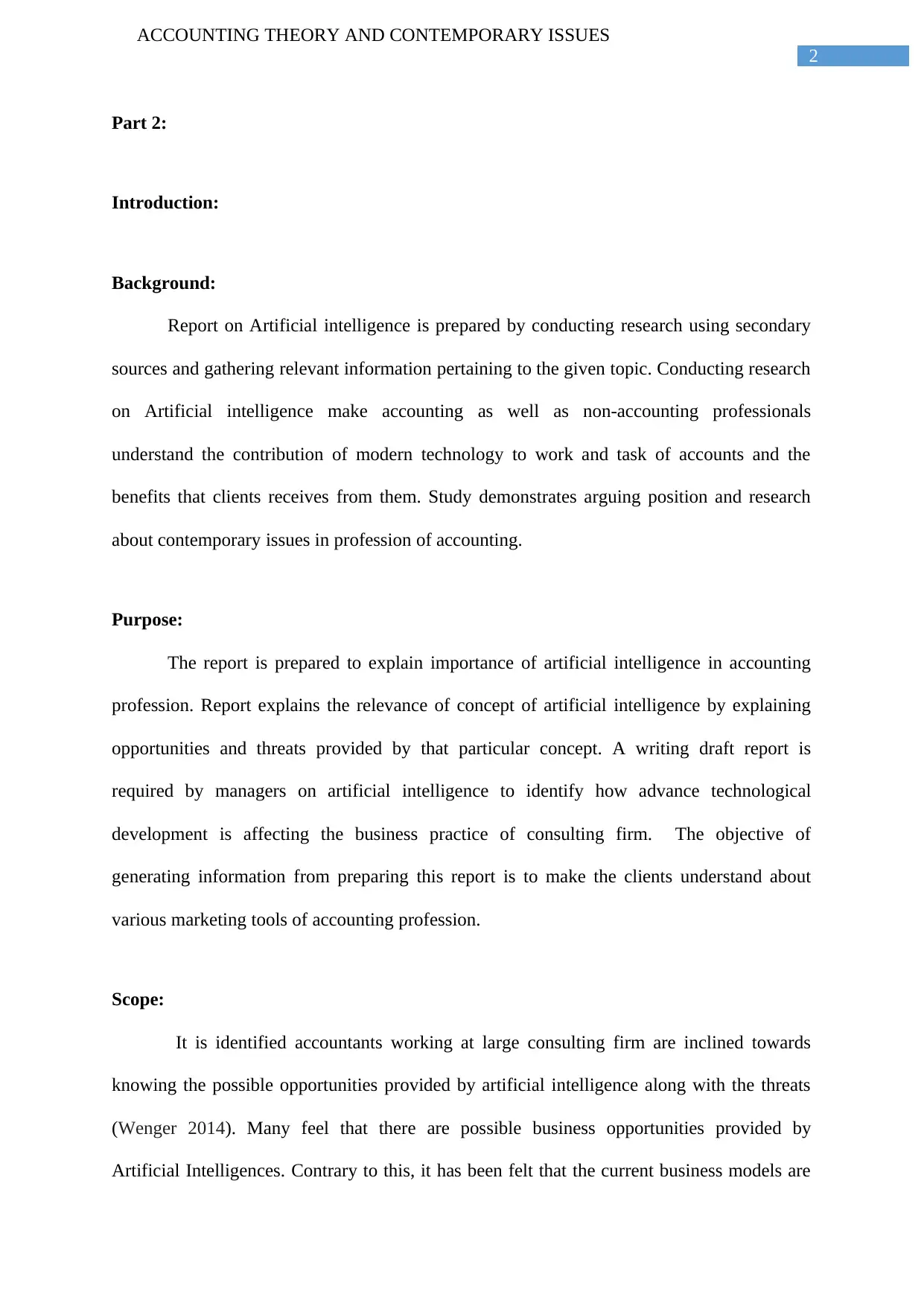
2
ACCOUNTING THEORY AND CONTEMPORARY ISSUES
Part 2:
Introduction:
Background:
Report on Artificial intelligence is prepared by conducting research using secondary
sources and gathering relevant information pertaining to the given topic. Conducting research
on Artificial intelligence make accounting as well as non-accounting professionals
understand the contribution of modern technology to work and task of accounts and the
benefits that clients receives from them. Study demonstrates arguing position and research
about contemporary issues in profession of accounting.
Purpose:
The report is prepared to explain importance of artificial intelligence in accounting
profession. Report explains the relevance of concept of artificial intelligence by explaining
opportunities and threats provided by that particular concept. A writing draft report is
required by managers on artificial intelligence to identify how advance technological
development is affecting the business practice of consulting firm. The objective of
generating information from preparing this report is to make the clients understand about
various marketing tools of accounting profession.
Scope:
It is identified accountants working at large consulting firm are inclined towards
knowing the possible opportunities provided by artificial intelligence along with the threats
(Wenger 2014). Many feel that there are possible business opportunities provided by
Artificial Intelligences. Contrary to this, it has been felt that the current business models are
ACCOUNTING THEORY AND CONTEMPORARY ISSUES
Part 2:
Introduction:
Background:
Report on Artificial intelligence is prepared by conducting research using secondary
sources and gathering relevant information pertaining to the given topic. Conducting research
on Artificial intelligence make accounting as well as non-accounting professionals
understand the contribution of modern technology to work and task of accounts and the
benefits that clients receives from them. Study demonstrates arguing position and research
about contemporary issues in profession of accounting.
Purpose:
The report is prepared to explain importance of artificial intelligence in accounting
profession. Report explains the relevance of concept of artificial intelligence by explaining
opportunities and threats provided by that particular concept. A writing draft report is
required by managers on artificial intelligence to identify how advance technological
development is affecting the business practice of consulting firm. The objective of
generating information from preparing this report is to make the clients understand about
various marketing tools of accounting profession.
Scope:
It is identified accountants working at large consulting firm are inclined towards
knowing the possible opportunities provided by artificial intelligence along with the threats
(Wenger 2014). Many feel that there are possible business opportunities provided by
Artificial Intelligences. Contrary to this, it has been felt that the current business models are
⊘ This is a preview!⊘
Do you want full access?
Subscribe today to unlock all pages.

Trusted by 1+ million students worldwide
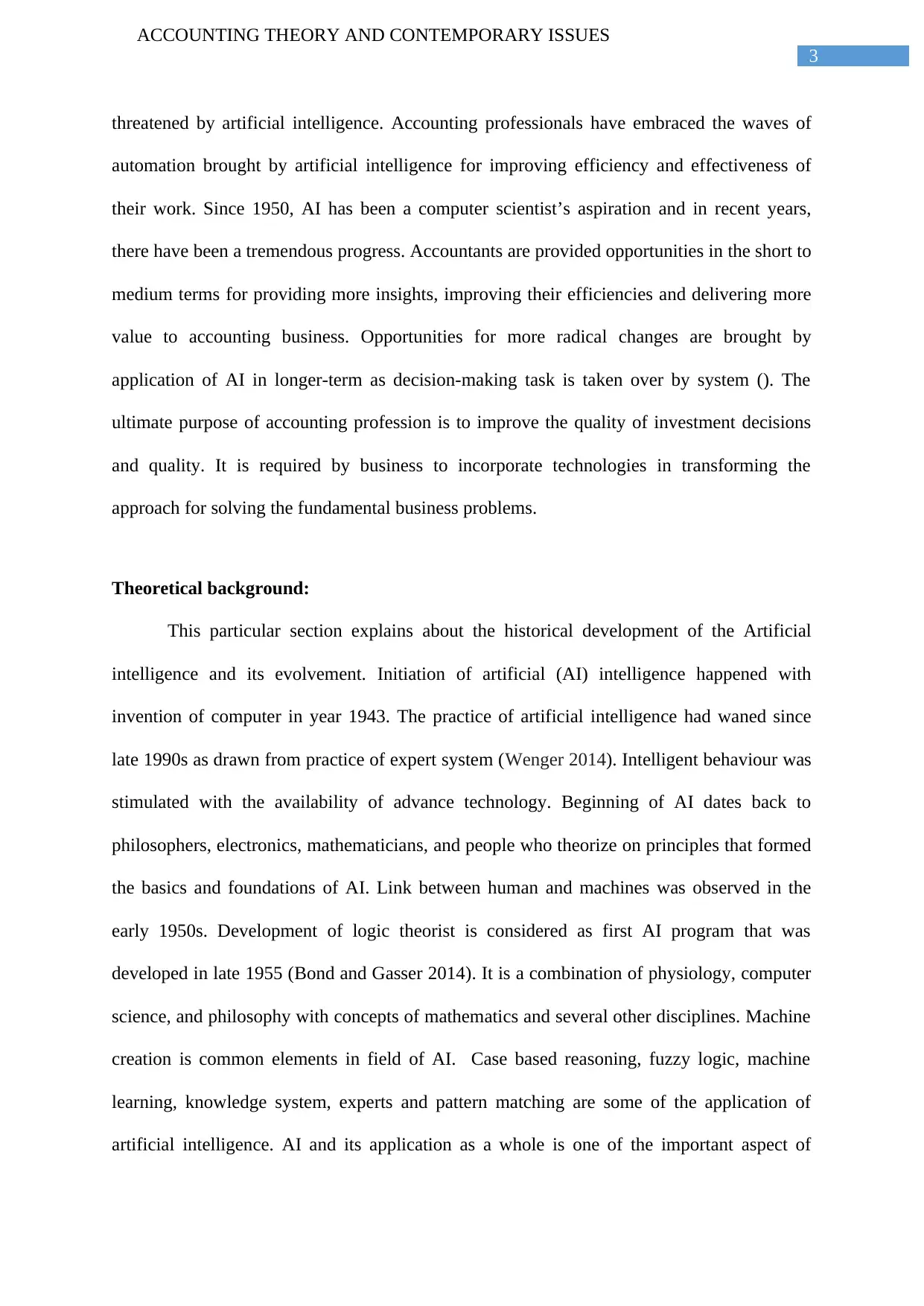
3
ACCOUNTING THEORY AND CONTEMPORARY ISSUES
threatened by artificial intelligence. Accounting professionals have embraced the waves of
automation brought by artificial intelligence for improving efficiency and effectiveness of
their work. Since 1950, AI has been a computer scientist’s aspiration and in recent years,
there have been a tremendous progress. Accountants are provided opportunities in the short to
medium terms for providing more insights, improving their efficiencies and delivering more
value to accounting business. Opportunities for more radical changes are brought by
application of AI in longer-term as decision-making task is taken over by system (). The
ultimate purpose of accounting profession is to improve the quality of investment decisions
and quality. It is required by business to incorporate technologies in transforming the
approach for solving the fundamental business problems.
Theoretical background:
This particular section explains about the historical development of the Artificial
intelligence and its evolvement. Initiation of artificial (AI) intelligence happened with
invention of computer in year 1943. The practice of artificial intelligence had waned since
late 1990s as drawn from practice of expert system (Wenger 2014). Intelligent behaviour was
stimulated with the availability of advance technology. Beginning of AI dates back to
philosophers, electronics, mathematicians, and people who theorize on principles that formed
the basics and foundations of AI. Link between human and machines was observed in the
early 1950s. Development of logic theorist is considered as first AI program that was
developed in late 1955 (Bond and Gasser 2014). It is a combination of physiology, computer
science, and philosophy with concepts of mathematics and several other disciplines. Machine
creation is common elements in field of AI. Case based reasoning, fuzzy logic, machine
learning, knowledge system, experts and pattern matching are some of the application of
artificial intelligence. AI and its application as a whole is one of the important aspect of
ACCOUNTING THEORY AND CONTEMPORARY ISSUES
threatened by artificial intelligence. Accounting professionals have embraced the waves of
automation brought by artificial intelligence for improving efficiency and effectiveness of
their work. Since 1950, AI has been a computer scientist’s aspiration and in recent years,
there have been a tremendous progress. Accountants are provided opportunities in the short to
medium terms for providing more insights, improving their efficiencies and delivering more
value to accounting business. Opportunities for more radical changes are brought by
application of AI in longer-term as decision-making task is taken over by system (). The
ultimate purpose of accounting profession is to improve the quality of investment decisions
and quality. It is required by business to incorporate technologies in transforming the
approach for solving the fundamental business problems.
Theoretical background:
This particular section explains about the historical development of the Artificial
intelligence and its evolvement. Initiation of artificial (AI) intelligence happened with
invention of computer in year 1943. The practice of artificial intelligence had waned since
late 1990s as drawn from practice of expert system (Wenger 2014). Intelligent behaviour was
stimulated with the availability of advance technology. Beginning of AI dates back to
philosophers, electronics, mathematicians, and people who theorize on principles that formed
the basics and foundations of AI. Link between human and machines was observed in the
early 1950s. Development of logic theorist is considered as first AI program that was
developed in late 1955 (Bond and Gasser 2014). It is a combination of physiology, computer
science, and philosophy with concepts of mathematics and several other disciplines. Machine
creation is common elements in field of AI. Case based reasoning, fuzzy logic, machine
learning, knowledge system, experts and pattern matching are some of the application of
artificial intelligence. AI and its application as a whole is one of the important aspect of
Paraphrase This Document
Need a fresh take? Get an instant paraphrase of this document with our AI Paraphraser
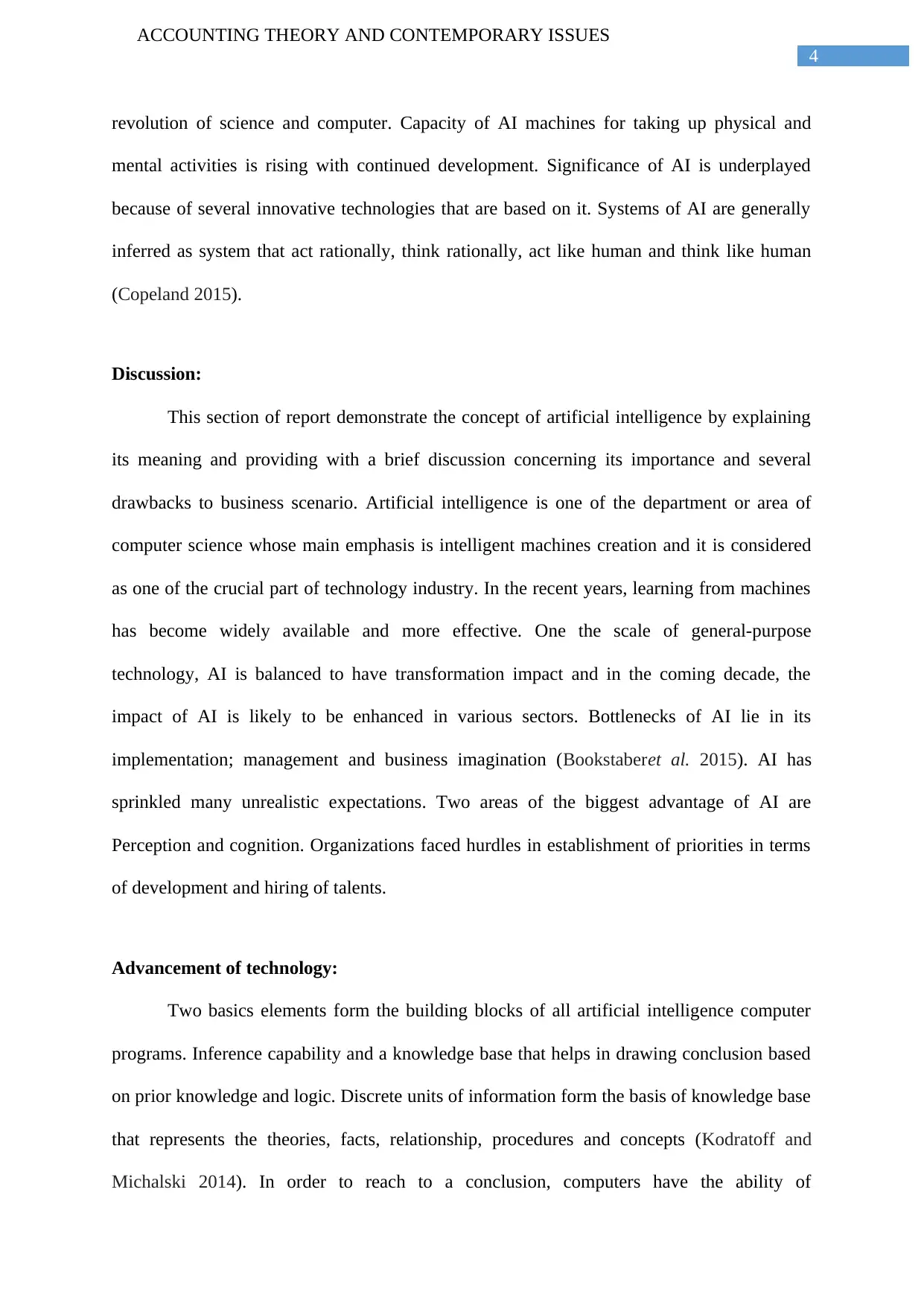
4
ACCOUNTING THEORY AND CONTEMPORARY ISSUES
revolution of science and computer. Capacity of AI machines for taking up physical and
mental activities is rising with continued development. Significance of AI is underplayed
because of several innovative technologies that are based on it. Systems of AI are generally
inferred as system that act rationally, think rationally, act like human and think like human
(Copeland 2015).
Discussion:
This section of report demonstrate the concept of artificial intelligence by explaining
its meaning and providing with a brief discussion concerning its importance and several
drawbacks to business scenario. Artificial intelligence is one of the department or area of
computer science whose main emphasis is intelligent machines creation and it is considered
as one of the crucial part of technology industry. In the recent years, learning from machines
has become widely available and more effective. One the scale of general-purpose
technology, AI is balanced to have transformation impact and in the coming decade, the
impact of AI is likely to be enhanced in various sectors. Bottlenecks of AI lie in its
implementation; management and business imagination (Bookstaberet al. 2015). AI has
sprinkled many unrealistic expectations. Two areas of the biggest advantage of AI are
Perception and cognition. Organizations faced hurdles in establishment of priorities in terms
of development and hiring of talents.
Advancement of technology:
Two basics elements form the building blocks of all artificial intelligence computer
programs. Inference capability and a knowledge base that helps in drawing conclusion based
on prior knowledge and logic. Discrete units of information form the basis of knowledge base
that represents the theories, facts, relationship, procedures and concepts (Kodratoff and
Michalski 2014). In order to reach to a conclusion, computers have the ability of
ACCOUNTING THEORY AND CONTEMPORARY ISSUES
revolution of science and computer. Capacity of AI machines for taking up physical and
mental activities is rising with continued development. Significance of AI is underplayed
because of several innovative technologies that are based on it. Systems of AI are generally
inferred as system that act rationally, think rationally, act like human and think like human
(Copeland 2015).
Discussion:
This section of report demonstrate the concept of artificial intelligence by explaining
its meaning and providing with a brief discussion concerning its importance and several
drawbacks to business scenario. Artificial intelligence is one of the department or area of
computer science whose main emphasis is intelligent machines creation and it is considered
as one of the crucial part of technology industry. In the recent years, learning from machines
has become widely available and more effective. One the scale of general-purpose
technology, AI is balanced to have transformation impact and in the coming decade, the
impact of AI is likely to be enhanced in various sectors. Bottlenecks of AI lie in its
implementation; management and business imagination (Bookstaberet al. 2015). AI has
sprinkled many unrealistic expectations. Two areas of the biggest advantage of AI are
Perception and cognition. Organizations faced hurdles in establishment of priorities in terms
of development and hiring of talents.
Advancement of technology:
Two basics elements form the building blocks of all artificial intelligence computer
programs. Inference capability and a knowledge base that helps in drawing conclusion based
on prior knowledge and logic. Discrete units of information form the basis of knowledge base
that represents the theories, facts, relationship, procedures and concepts (Kodratoff and
Michalski 2014). In order to reach to a conclusion, computers have the ability of
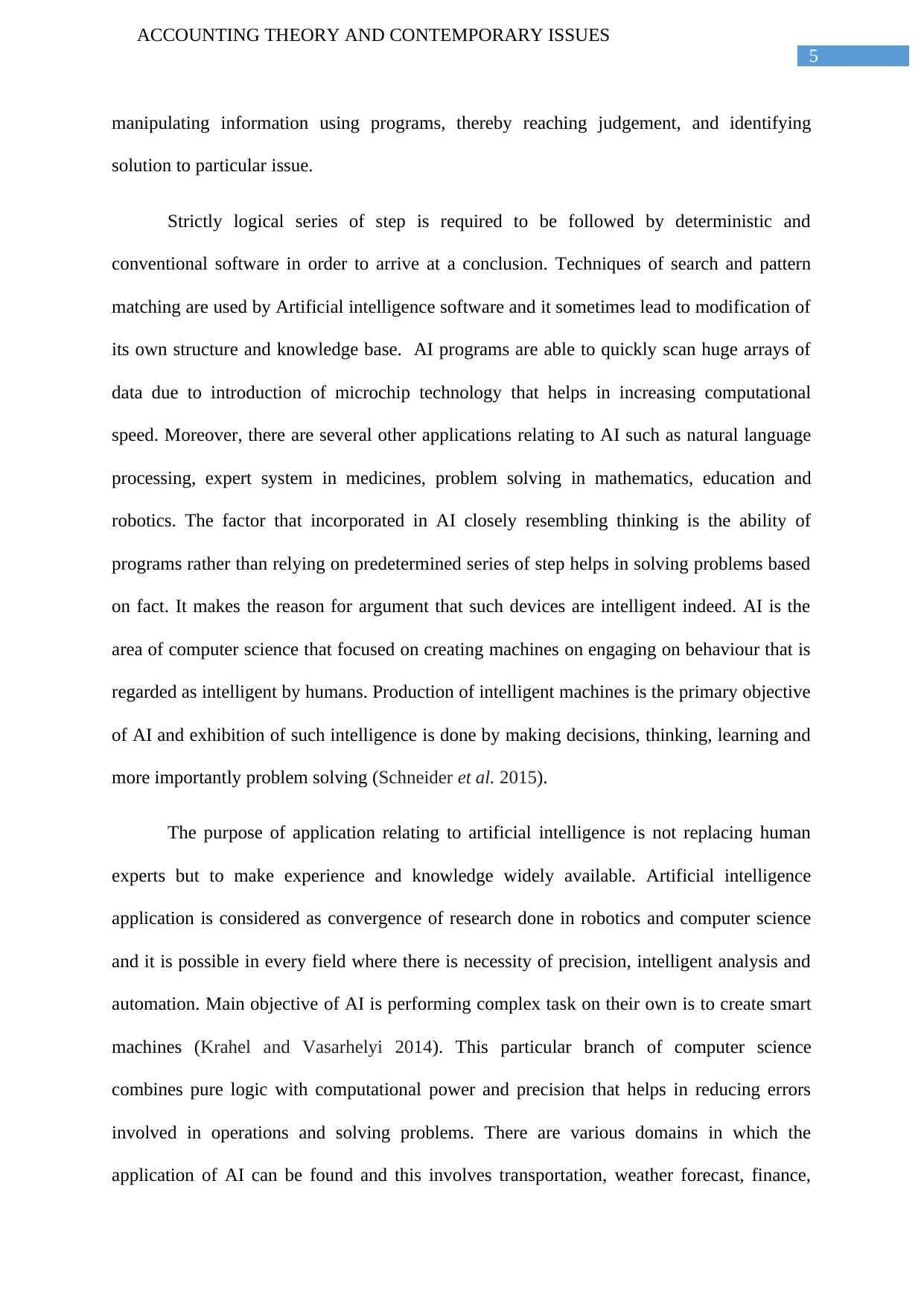
5
ACCOUNTING THEORY AND CONTEMPORARY ISSUES
manipulating information using programs, thereby reaching judgement, and identifying
solution to particular issue.
Strictly logical series of step is required to be followed by deterministic and
conventional software in order to arrive at a conclusion. Techniques of search and pattern
matching are used by Artificial intelligence software and it sometimes lead to modification of
its own structure and knowledge base. AI programs are able to quickly scan huge arrays of
data due to introduction of microchip technology that helps in increasing computational
speed. Moreover, there are several other applications relating to AI such as natural language
processing, expert system in medicines, problem solving in mathematics, education and
robotics. The factor that incorporated in AI closely resembling thinking is the ability of
programs rather than relying on predetermined series of step helps in solving problems based
on fact. It makes the reason for argument that such devices are intelligent indeed. AI is the
area of computer science that focused on creating machines on engaging on behaviour that is
regarded as intelligent by humans. Production of intelligent machines is the primary objective
of AI and exhibition of such intelligence is done by making decisions, thinking, learning and
more importantly problem solving (Schneider et al. 2015).
The purpose of application relating to artificial intelligence is not replacing human
experts but to make experience and knowledge widely available. Artificial intelligence
application is considered as convergence of research done in robotics and computer science
and it is possible in every field where there is necessity of precision, intelligent analysis and
automation. Main objective of AI is performing complex task on their own is to create smart
machines (Krahel and Vasarhelyi 2014). This particular branch of computer science
combines pure logic with computational power and precision that helps in reducing errors
involved in operations and solving problems. There are various domains in which the
application of AI can be found and this involves transportation, weather forecast, finance,
ACCOUNTING THEORY AND CONTEMPORARY ISSUES
manipulating information using programs, thereby reaching judgement, and identifying
solution to particular issue.
Strictly logical series of step is required to be followed by deterministic and
conventional software in order to arrive at a conclusion. Techniques of search and pattern
matching are used by Artificial intelligence software and it sometimes lead to modification of
its own structure and knowledge base. AI programs are able to quickly scan huge arrays of
data due to introduction of microchip technology that helps in increasing computational
speed. Moreover, there are several other applications relating to AI such as natural language
processing, expert system in medicines, problem solving in mathematics, education and
robotics. The factor that incorporated in AI closely resembling thinking is the ability of
programs rather than relying on predetermined series of step helps in solving problems based
on fact. It makes the reason for argument that such devices are intelligent indeed. AI is the
area of computer science that focused on creating machines on engaging on behaviour that is
regarded as intelligent by humans. Production of intelligent machines is the primary objective
of AI and exhibition of such intelligence is done by making decisions, thinking, learning and
more importantly problem solving (Schneider et al. 2015).
The purpose of application relating to artificial intelligence is not replacing human
experts but to make experience and knowledge widely available. Artificial intelligence
application is considered as convergence of research done in robotics and computer science
and it is possible in every field where there is necessity of precision, intelligent analysis and
automation. Main objective of AI is performing complex task on their own is to create smart
machines (Krahel and Vasarhelyi 2014). This particular branch of computer science
combines pure logic with computational power and precision that helps in reducing errors
involved in operations and solving problems. There are various domains in which the
application of AI can be found and this involves transportation, weather forecast, finance,
⊘ This is a preview!⊘
Do you want full access?
Subscribe today to unlock all pages.

Trusted by 1+ million students worldwide
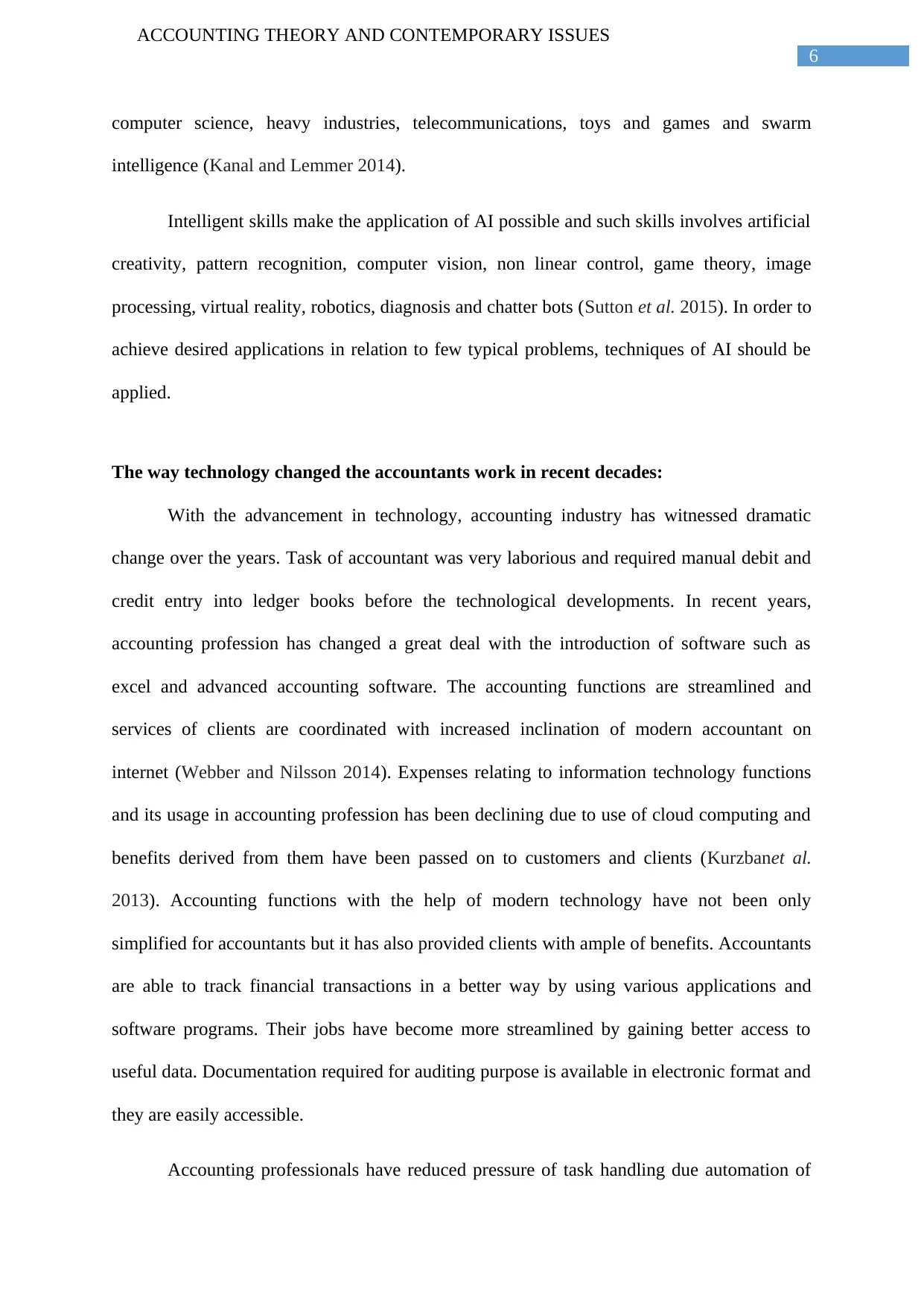
6
ACCOUNTING THEORY AND CONTEMPORARY ISSUES
computer science, heavy industries, telecommunications, toys and games and swarm
intelligence (Kanal and Lemmer 2014).
Intelligent skills make the application of AI possible and such skills involves artificial
creativity, pattern recognition, computer vision, non linear control, game theory, image
processing, virtual reality, robotics, diagnosis and chatter bots (Sutton et al. 2015). In order to
achieve desired applications in relation to few typical problems, techniques of AI should be
applied.
The way technology changed the accountants work in recent decades:
With the advancement in technology, accounting industry has witnessed dramatic
change over the years. Task of accountant was very laborious and required manual debit and
credit entry into ledger books before the technological developments. In recent years,
accounting profession has changed a great deal with the introduction of software such as
excel and advanced accounting software. The accounting functions are streamlined and
services of clients are coordinated with increased inclination of modern accountant on
internet (Webber and Nilsson 2014). Expenses relating to information technology functions
and its usage in accounting profession has been declining due to use of cloud computing and
benefits derived from them have been passed on to customers and clients (Kurzbanet al.
2013). Accounting functions with the help of modern technology have not been only
simplified for accountants but it has also provided clients with ample of benefits. Accountants
are able to track financial transactions in a better way by using various applications and
software programs. Their jobs have become more streamlined by gaining better access to
useful data. Documentation required for auditing purpose is available in electronic format and
they are easily accessible.
Accounting professionals have reduced pressure of task handling due automation of
ACCOUNTING THEORY AND CONTEMPORARY ISSUES
computer science, heavy industries, telecommunications, toys and games and swarm
intelligence (Kanal and Lemmer 2014).
Intelligent skills make the application of AI possible and such skills involves artificial
creativity, pattern recognition, computer vision, non linear control, game theory, image
processing, virtual reality, robotics, diagnosis and chatter bots (Sutton et al. 2015). In order to
achieve desired applications in relation to few typical problems, techniques of AI should be
applied.
The way technology changed the accountants work in recent decades:
With the advancement in technology, accounting industry has witnessed dramatic
change over the years. Task of accountant was very laborious and required manual debit and
credit entry into ledger books before the technological developments. In recent years,
accounting profession has changed a great deal with the introduction of software such as
excel and advanced accounting software. The accounting functions are streamlined and
services of clients are coordinated with increased inclination of modern accountant on
internet (Webber and Nilsson 2014). Expenses relating to information technology functions
and its usage in accounting profession has been declining due to use of cloud computing and
benefits derived from them have been passed on to customers and clients (Kurzbanet al.
2013). Accounting functions with the help of modern technology have not been only
simplified for accountants but it has also provided clients with ample of benefits. Accountants
are able to track financial transactions in a better way by using various applications and
software programs. Their jobs have become more streamlined by gaining better access to
useful data. Documentation required for auditing purpose is available in electronic format and
they are easily accessible.
Accounting professionals have reduced pressure of task handling due automation of
Paraphrase This Document
Need a fresh take? Get an instant paraphrase of this document with our AI Paraphraser
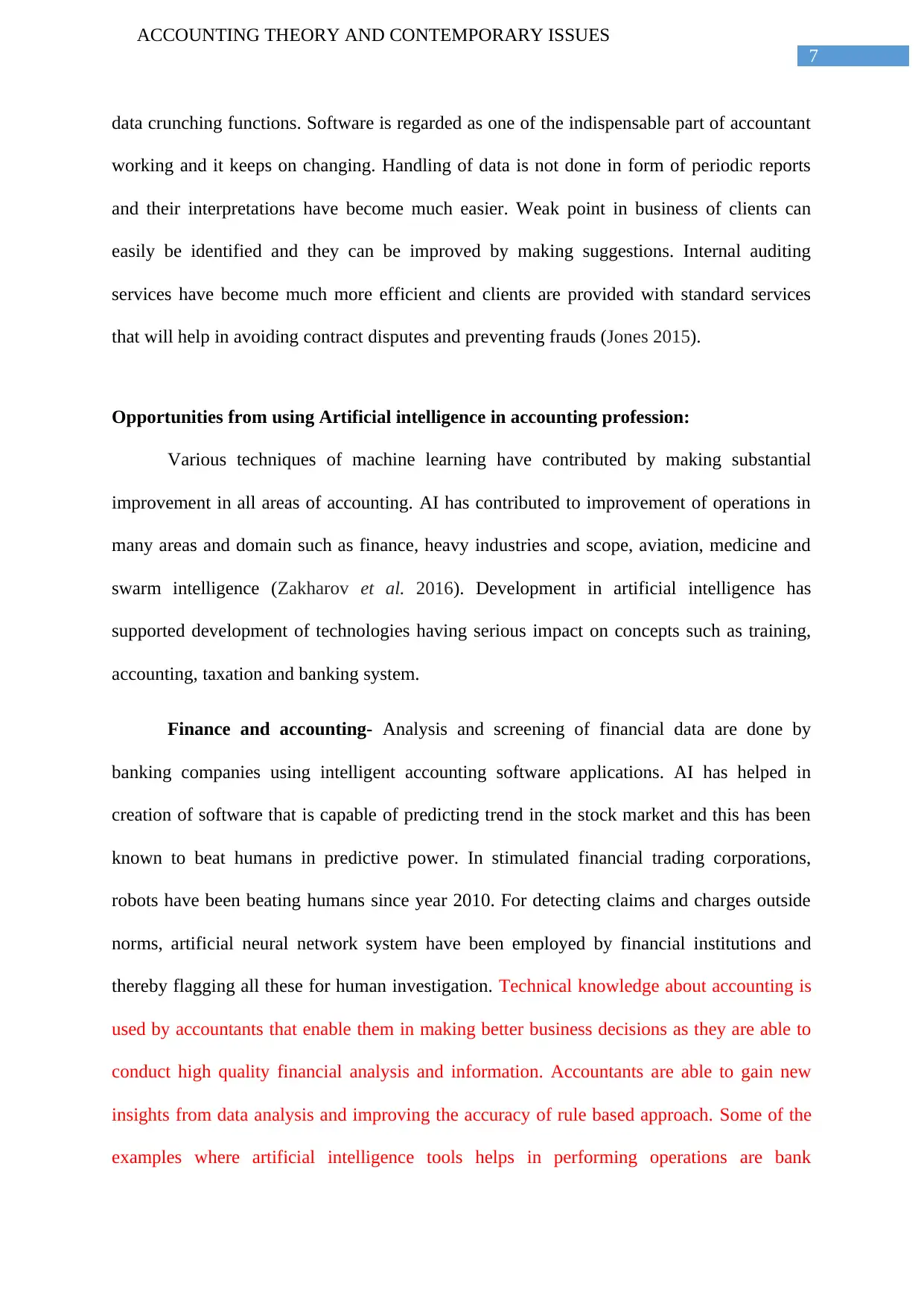
7
ACCOUNTING THEORY AND CONTEMPORARY ISSUES
data crunching functions. Software is regarded as one of the indispensable part of accountant
working and it keeps on changing. Handling of data is not done in form of periodic reports
and their interpretations have become much easier. Weak point in business of clients can
easily be identified and they can be improved by making suggestions. Internal auditing
services have become much more efficient and clients are provided with standard services
that will help in avoiding contract disputes and preventing frauds (Jones 2015).
Opportunities from using Artificial intelligence in accounting profession:
Various techniques of machine learning have contributed by making substantial
improvement in all areas of accounting. AI has contributed to improvement of operations in
many areas and domain such as finance, heavy industries and scope, aviation, medicine and
swarm intelligence (Zakharov et al. 2016). Development in artificial intelligence has
supported development of technologies having serious impact on concepts such as training,
accounting, taxation and banking system.
Finance and accounting- Analysis and screening of financial data are done by
banking companies using intelligent accounting software applications. AI has helped in
creation of software that is capable of predicting trend in the stock market and this has been
known to beat humans in predictive power. In stimulated financial trading corporations,
robots have been beating humans since year 2010. For detecting claims and charges outside
norms, artificial neural network system have been employed by financial institutions and
thereby flagging all these for human investigation. Technical knowledge about accounting is
used by accountants that enable them in making better business decisions as they are able to
conduct high quality financial analysis and information. Accountants are able to gain new
insights from data analysis and improving the accuracy of rule based approach. Some of the
examples where artificial intelligence tools helps in performing operations are bank
ACCOUNTING THEORY AND CONTEMPORARY ISSUES
data crunching functions. Software is regarded as one of the indispensable part of accountant
working and it keeps on changing. Handling of data is not done in form of periodic reports
and their interpretations have become much easier. Weak point in business of clients can
easily be identified and they can be improved by making suggestions. Internal auditing
services have become much more efficient and clients are provided with standard services
that will help in avoiding contract disputes and preventing frauds (Jones 2015).
Opportunities from using Artificial intelligence in accounting profession:
Various techniques of machine learning have contributed by making substantial
improvement in all areas of accounting. AI has contributed to improvement of operations in
many areas and domain such as finance, heavy industries and scope, aviation, medicine and
swarm intelligence (Zakharov et al. 2016). Development in artificial intelligence has
supported development of technologies having serious impact on concepts such as training,
accounting, taxation and banking system.
Finance and accounting- Analysis and screening of financial data are done by
banking companies using intelligent accounting software applications. AI has helped in
creation of software that is capable of predicting trend in the stock market and this has been
known to beat humans in predictive power. In stimulated financial trading corporations,
robots have been beating humans since year 2010. For detecting claims and charges outside
norms, artificial neural network system have been employed by financial institutions and
thereby flagging all these for human investigation. Technical knowledge about accounting is
used by accountants that enable them in making better business decisions as they are able to
conduct high quality financial analysis and information. Accountants are able to gain new
insights from data analysis and improving the accuracy of rule based approach. Some of the
examples where artificial intelligence tools helps in performing operations are bank
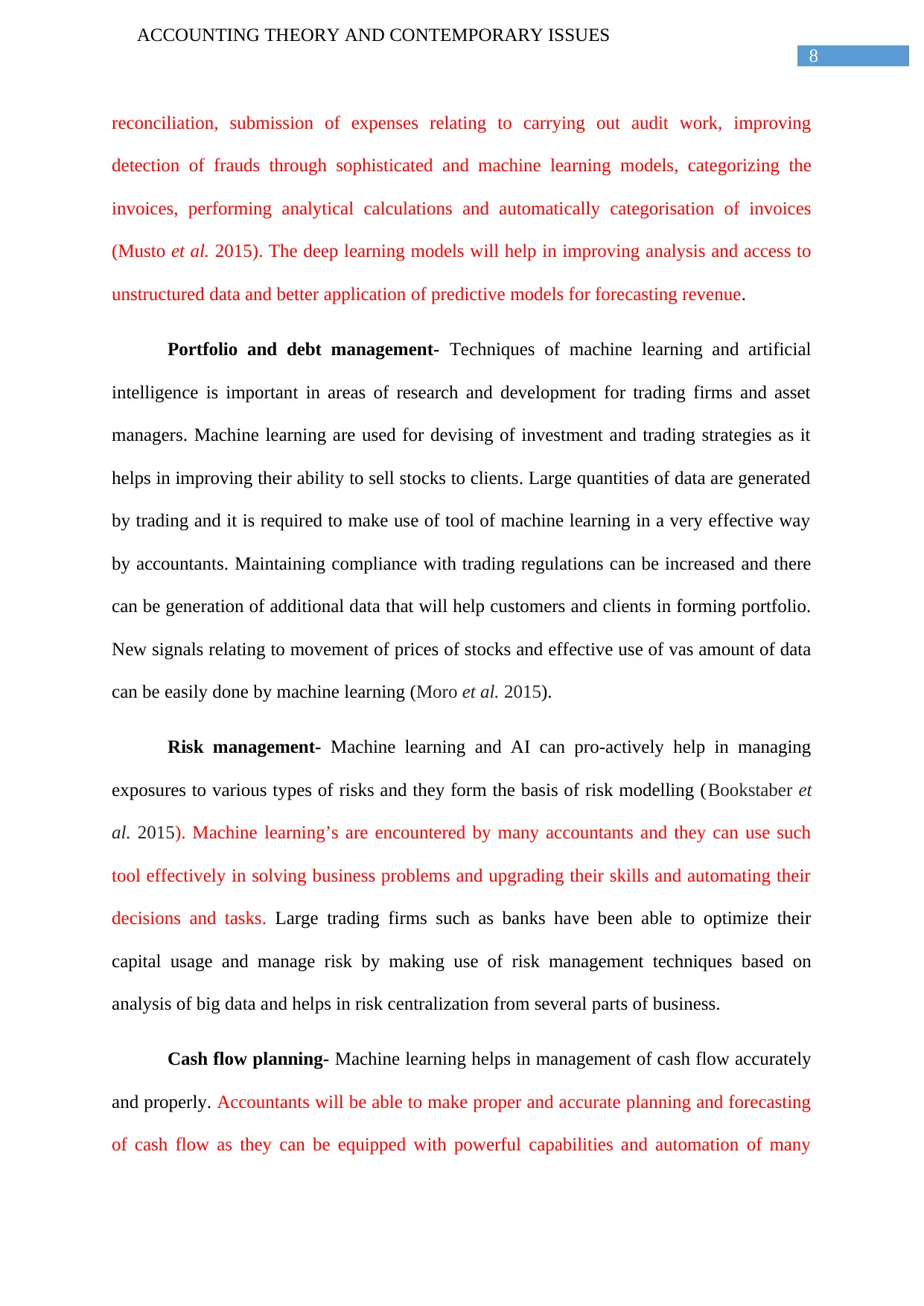
8
ACCOUNTING THEORY AND CONTEMPORARY ISSUES
reconciliation, submission of expenses relating to carrying out audit work, improving
detection of frauds through sophisticated and machine learning models, categorizing the
invoices, performing analytical calculations and automatically categorisation of invoices
(Musto et al. 2015). The deep learning models will help in improving analysis and access to
unstructured data and better application of predictive models for forecasting revenue.
Portfolio and debt management- Techniques of machine learning and artificial
intelligence is important in areas of research and development for trading firms and asset
managers. Machine learning are used for devising of investment and trading strategies as it
helps in improving their ability to sell stocks to clients. Large quantities of data are generated
by trading and it is required to make use of tool of machine learning in a very effective way
by accountants. Maintaining compliance with trading regulations can be increased and there
can be generation of additional data that will help customers and clients in forming portfolio.
New signals relating to movement of prices of stocks and effective use of vas amount of data
can be easily done by machine learning (Moro et al. 2015).
Risk management- Machine learning and AI can pro-actively help in managing
exposures to various types of risks and they form the basis of risk modelling (Bookstaber et
al. 2015). Machine learning’s are encountered by many accountants and they can use such
tool effectively in solving business problems and upgrading their skills and automating their
decisions and tasks. Large trading firms such as banks have been able to optimize their
capital usage and manage risk by making use of risk management techniques based on
analysis of big data and helps in risk centralization from several parts of business.
Cash flow planning- Machine learning helps in management of cash flow accurately
and properly. Accountants will be able to make proper and accurate planning and forecasting
of cash flow as they can be equipped with powerful capabilities and automation of many
ACCOUNTING THEORY AND CONTEMPORARY ISSUES
reconciliation, submission of expenses relating to carrying out audit work, improving
detection of frauds through sophisticated and machine learning models, categorizing the
invoices, performing analytical calculations and automatically categorisation of invoices
(Musto et al. 2015). The deep learning models will help in improving analysis and access to
unstructured data and better application of predictive models for forecasting revenue.
Portfolio and debt management- Techniques of machine learning and artificial
intelligence is important in areas of research and development for trading firms and asset
managers. Machine learning are used for devising of investment and trading strategies as it
helps in improving their ability to sell stocks to clients. Large quantities of data are generated
by trading and it is required to make use of tool of machine learning in a very effective way
by accountants. Maintaining compliance with trading regulations can be increased and there
can be generation of additional data that will help customers and clients in forming portfolio.
New signals relating to movement of prices of stocks and effective use of vas amount of data
can be easily done by machine learning (Moro et al. 2015).
Risk management- Machine learning and AI can pro-actively help in managing
exposures to various types of risks and they form the basis of risk modelling (Bookstaber et
al. 2015). Machine learning’s are encountered by many accountants and they can use such
tool effectively in solving business problems and upgrading their skills and automating their
decisions and tasks. Large trading firms such as banks have been able to optimize their
capital usage and manage risk by making use of risk management techniques based on
analysis of big data and helps in risk centralization from several parts of business.
Cash flow planning- Machine learning helps in management of cash flow accurately
and properly. Accountants will be able to make proper and accurate planning and forecasting
of cash flow as they can be equipped with powerful capabilities and automation of many
⊘ This is a preview!⊘
Do you want full access?
Subscribe today to unlock all pages.

Trusted by 1+ million students worldwide
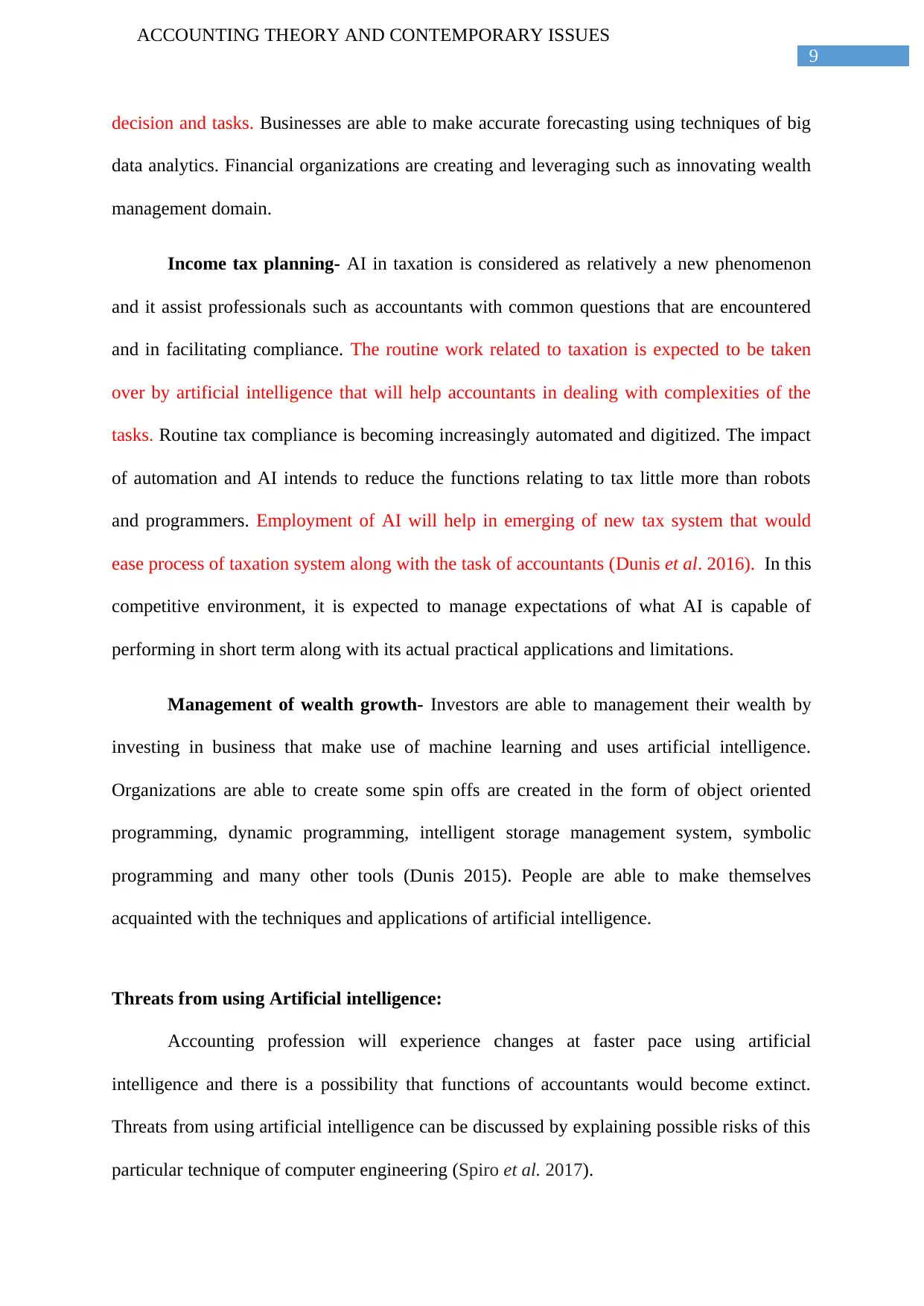
9
ACCOUNTING THEORY AND CONTEMPORARY ISSUES
decision and tasks. Businesses are able to make accurate forecasting using techniques of big
data analytics. Financial organizations are creating and leveraging such as innovating wealth
management domain.
Income tax planning- AI in taxation is considered as relatively a new phenomenon
and it assist professionals such as accountants with common questions that are encountered
and in facilitating compliance. The routine work related to taxation is expected to be taken
over by artificial intelligence that will help accountants in dealing with complexities of the
tasks. Routine tax compliance is becoming increasingly automated and digitized. The impact
of automation and AI intends to reduce the functions relating to tax little more than robots
and programmers. Employment of AI will help in emerging of new tax system that would
ease process of taxation system along with the task of accountants (Dunis et al. 2016). In this
competitive environment, it is expected to manage expectations of what AI is capable of
performing in short term along with its actual practical applications and limitations.
Management of wealth growth- Investors are able to management their wealth by
investing in business that make use of machine learning and uses artificial intelligence.
Organizations are able to create some spin offs are created in the form of object oriented
programming, dynamic programming, intelligent storage management system, symbolic
programming and many other tools (Dunis 2015). People are able to make themselves
acquainted with the techniques and applications of artificial intelligence.
Threats from using Artificial intelligence:
Accounting profession will experience changes at faster pace using artificial
intelligence and there is a possibility that functions of accountants would become extinct.
Threats from using artificial intelligence can be discussed by explaining possible risks of this
particular technique of computer engineering (Spiro et al. 2017).
ACCOUNTING THEORY AND CONTEMPORARY ISSUES
decision and tasks. Businesses are able to make accurate forecasting using techniques of big
data analytics. Financial organizations are creating and leveraging such as innovating wealth
management domain.
Income tax planning- AI in taxation is considered as relatively a new phenomenon
and it assist professionals such as accountants with common questions that are encountered
and in facilitating compliance. The routine work related to taxation is expected to be taken
over by artificial intelligence that will help accountants in dealing with complexities of the
tasks. Routine tax compliance is becoming increasingly automated and digitized. The impact
of automation and AI intends to reduce the functions relating to tax little more than robots
and programmers. Employment of AI will help in emerging of new tax system that would
ease process of taxation system along with the task of accountants (Dunis et al. 2016). In this
competitive environment, it is expected to manage expectations of what AI is capable of
performing in short term along with its actual practical applications and limitations.
Management of wealth growth- Investors are able to management their wealth by
investing in business that make use of machine learning and uses artificial intelligence.
Organizations are able to create some spin offs are created in the form of object oriented
programming, dynamic programming, intelligent storage management system, symbolic
programming and many other tools (Dunis 2015). People are able to make themselves
acquainted with the techniques and applications of artificial intelligence.
Threats from using Artificial intelligence:
Accounting profession will experience changes at faster pace using artificial
intelligence and there is a possibility that functions of accountants would become extinct.
Threats from using artificial intelligence can be discussed by explaining possible risks of this
particular technique of computer engineering (Spiro et al. 2017).
Paraphrase This Document
Need a fresh take? Get an instant paraphrase of this document with our AI Paraphraser
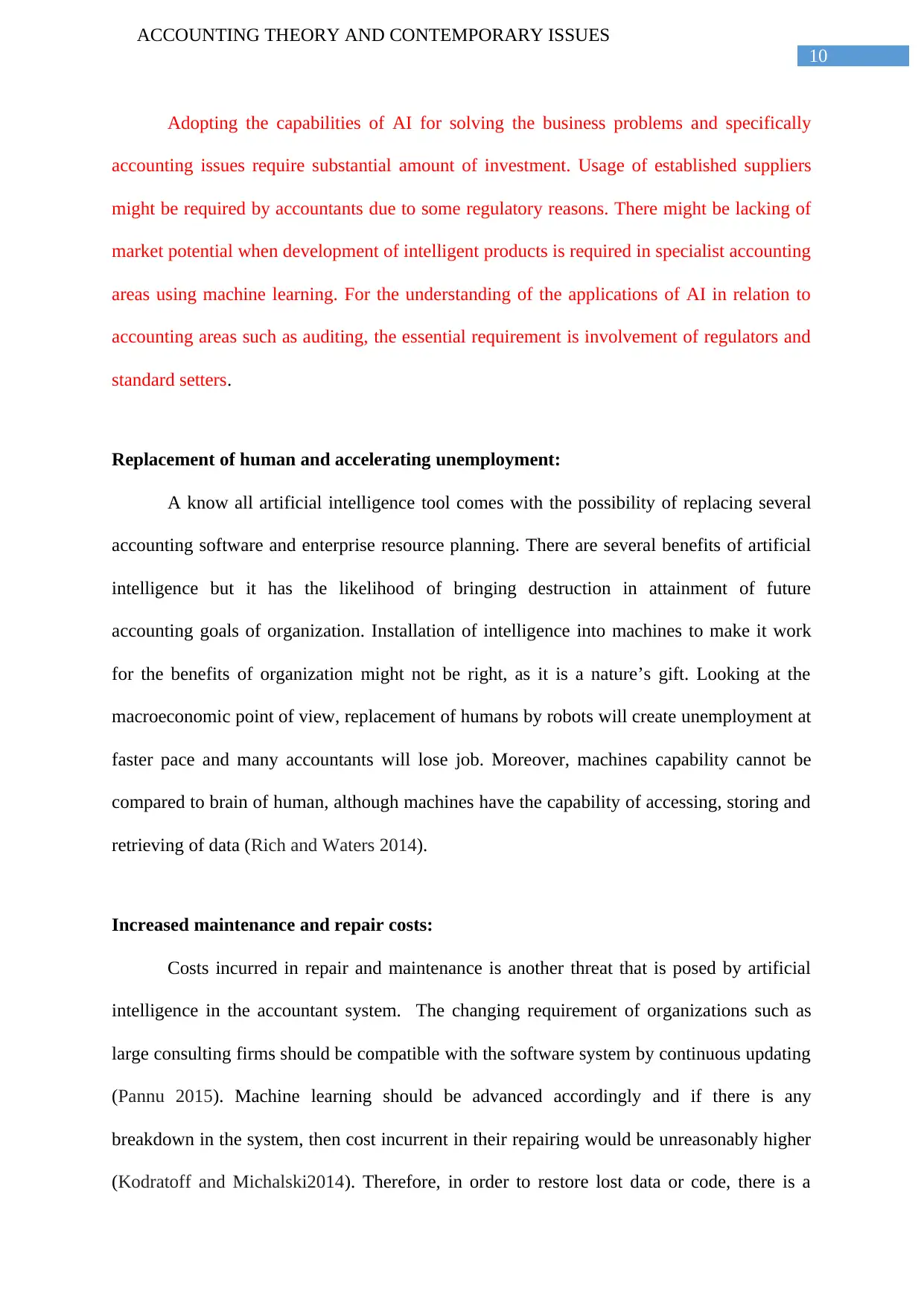
10
ACCOUNTING THEORY AND CONTEMPORARY ISSUES
Adopting the capabilities of AI for solving the business problems and specifically
accounting issues require substantial amount of investment. Usage of established suppliers
might be required by accountants due to some regulatory reasons. There might be lacking of
market potential when development of intelligent products is required in specialist accounting
areas using machine learning. For the understanding of the applications of AI in relation to
accounting areas such as auditing, the essential requirement is involvement of regulators and
standard setters.
Replacement of human and accelerating unemployment:
A know all artificial intelligence tool comes with the possibility of replacing several
accounting software and enterprise resource planning. There are several benefits of artificial
intelligence but it has the likelihood of bringing destruction in attainment of future
accounting goals of organization. Installation of intelligence into machines to make it work
for the benefits of organization might not be right, as it is a nature’s gift. Looking at the
macroeconomic point of view, replacement of humans by robots will create unemployment at
faster pace and many accountants will lose job. Moreover, machines capability cannot be
compared to brain of human, although machines have the capability of accessing, storing and
retrieving of data (Rich and Waters 2014).
Increased maintenance and repair costs:
Costs incurred in repair and maintenance is another threat that is posed by artificial
intelligence in the accountant system. The changing requirement of organizations such as
large consulting firms should be compatible with the software system by continuous updating
(Pannu 2015). Machine learning should be advanced accordingly and if there is any
breakdown in the system, then cost incurrent in their repairing would be unreasonably higher
(Kodratoff and Michalski2014). Therefore, in order to restore lost data or code, there is a
ACCOUNTING THEORY AND CONTEMPORARY ISSUES
Adopting the capabilities of AI for solving the business problems and specifically
accounting issues require substantial amount of investment. Usage of established suppliers
might be required by accountants due to some regulatory reasons. There might be lacking of
market potential when development of intelligent products is required in specialist accounting
areas using machine learning. For the understanding of the applications of AI in relation to
accounting areas such as auditing, the essential requirement is involvement of regulators and
standard setters.
Replacement of human and accelerating unemployment:
A know all artificial intelligence tool comes with the possibility of replacing several
accounting software and enterprise resource planning. There are several benefits of artificial
intelligence but it has the likelihood of bringing destruction in attainment of future
accounting goals of organization. Installation of intelligence into machines to make it work
for the benefits of organization might not be right, as it is a nature’s gift. Looking at the
macroeconomic point of view, replacement of humans by robots will create unemployment at
faster pace and many accountants will lose job. Moreover, machines capability cannot be
compared to brain of human, although machines have the capability of accessing, storing and
retrieving of data (Rich and Waters 2014).
Increased maintenance and repair costs:
Costs incurred in repair and maintenance is another threat that is posed by artificial
intelligence in the accountant system. The changing requirement of organizations such as
large consulting firms should be compatible with the software system by continuous updating
(Pannu 2015). Machine learning should be advanced accordingly and if there is any
breakdown in the system, then cost incurrent in their repairing would be unreasonably higher
(Kodratoff and Michalski2014). Therefore, in order to restore lost data or code, there is a
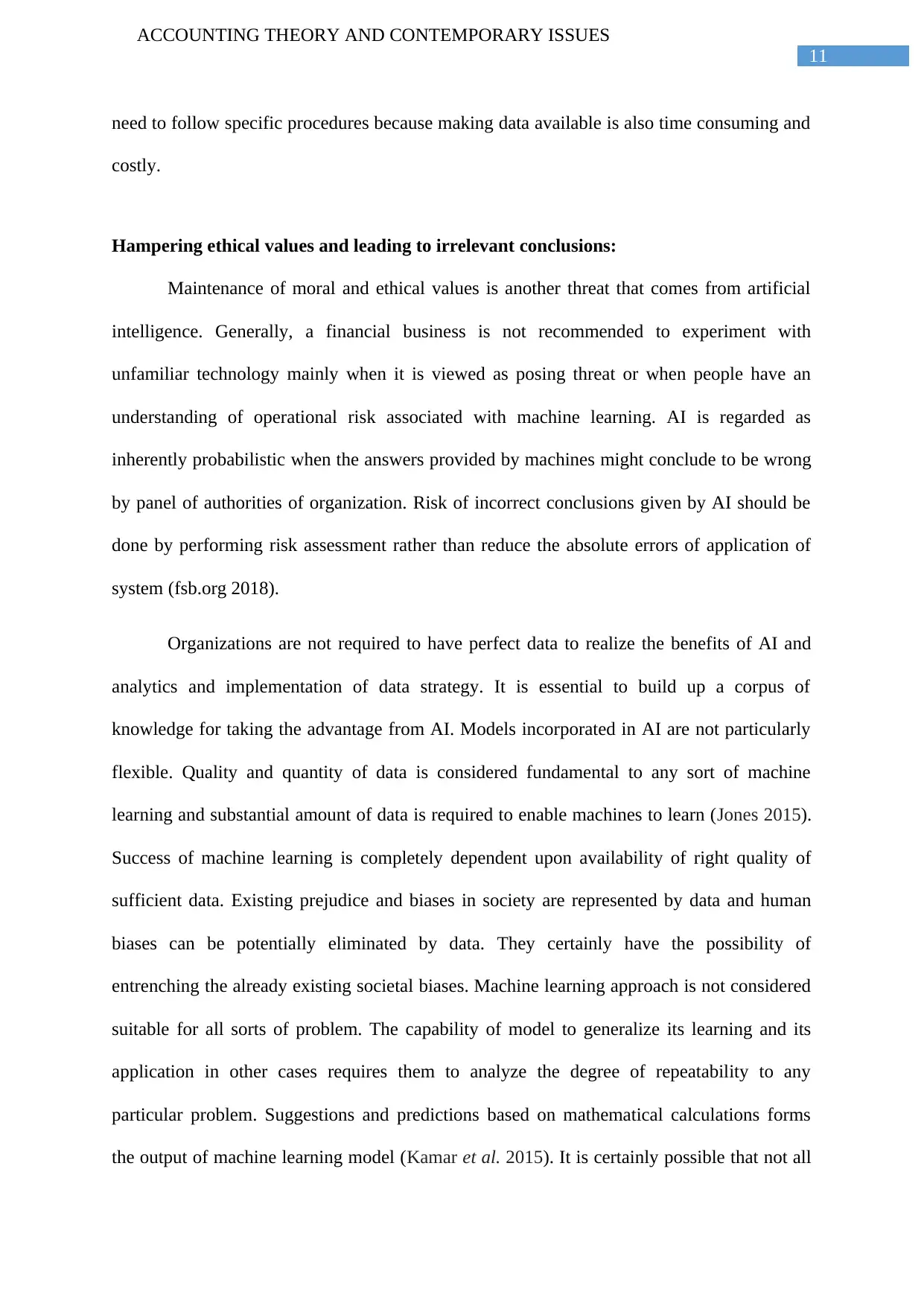
11
ACCOUNTING THEORY AND CONTEMPORARY ISSUES
need to follow specific procedures because making data available is also time consuming and
costly.
Hampering ethical values and leading to irrelevant conclusions:
Maintenance of moral and ethical values is another threat that comes from artificial
intelligence. Generally, a financial business is not recommended to experiment with
unfamiliar technology mainly when it is viewed as posing threat or when people have an
understanding of operational risk associated with machine learning. AI is regarded as
inherently probabilistic when the answers provided by machines might conclude to be wrong
by panel of authorities of organization. Risk of incorrect conclusions given by AI should be
done by performing risk assessment rather than reduce the absolute errors of application of
system (fsb.org 2018).
Organizations are not required to have perfect data to realize the benefits of AI and
analytics and implementation of data strategy. It is essential to build up a corpus of
knowledge for taking the advantage from AI. Models incorporated in AI are not particularly
flexible. Quality and quantity of data is considered fundamental to any sort of machine
learning and substantial amount of data is required to enable machines to learn (Jones 2015).
Success of machine learning is completely dependent upon availability of right quality of
sufficient data. Existing prejudice and biases in society are represented by data and human
biases can be potentially eliminated by data. They certainly have the possibility of
entrenching the already existing societal biases. Machine learning approach is not considered
suitable for all sorts of problem. The capability of model to generalize its learning and its
application in other cases requires them to analyze the degree of repeatability to any
particular problem. Suggestions and predictions based on mathematical calculations forms
the output of machine learning model (Kamar et al. 2015). It is certainly possible that not all
ACCOUNTING THEORY AND CONTEMPORARY ISSUES
need to follow specific procedures because making data available is also time consuming and
costly.
Hampering ethical values and leading to irrelevant conclusions:
Maintenance of moral and ethical values is another threat that comes from artificial
intelligence. Generally, a financial business is not recommended to experiment with
unfamiliar technology mainly when it is viewed as posing threat or when people have an
understanding of operational risk associated with machine learning. AI is regarded as
inherently probabilistic when the answers provided by machines might conclude to be wrong
by panel of authorities of organization. Risk of incorrect conclusions given by AI should be
done by performing risk assessment rather than reduce the absolute errors of application of
system (fsb.org 2018).
Organizations are not required to have perfect data to realize the benefits of AI and
analytics and implementation of data strategy. It is essential to build up a corpus of
knowledge for taking the advantage from AI. Models incorporated in AI are not particularly
flexible. Quality and quantity of data is considered fundamental to any sort of machine
learning and substantial amount of data is required to enable machines to learn (Jones 2015).
Success of machine learning is completely dependent upon availability of right quality of
sufficient data. Existing prejudice and biases in society are represented by data and human
biases can be potentially eliminated by data. They certainly have the possibility of
entrenching the already existing societal biases. Machine learning approach is not considered
suitable for all sorts of problem. The capability of model to generalize its learning and its
application in other cases requires them to analyze the degree of repeatability to any
particular problem. Suggestions and predictions based on mathematical calculations forms
the output of machine learning model (Kamar et al. 2015). It is certainly possible that not all
⊘ This is a preview!⊘
Do you want full access?
Subscribe today to unlock all pages.

Trusted by 1+ million students worldwide
1 out of 20
Related Documents
Your All-in-One AI-Powered Toolkit for Academic Success.
+13062052269
info@desklib.com
Available 24*7 on WhatsApp / Email
![[object Object]](/_next/static/media/star-bottom.7253800d.svg)
Unlock your academic potential
Copyright © 2020–2025 A2Z Services. All Rights Reserved. Developed and managed by ZUCOL.




![[University Name] Accounting Theory and AI Implementation Report](/_next/image/?url=https%3A%2F%2Fdesklib.com%2Fmedia%2Fimages%2Flw%2Fae210f4ce1684f0ea806ae996f6461fb.jpg&w=256&q=75)